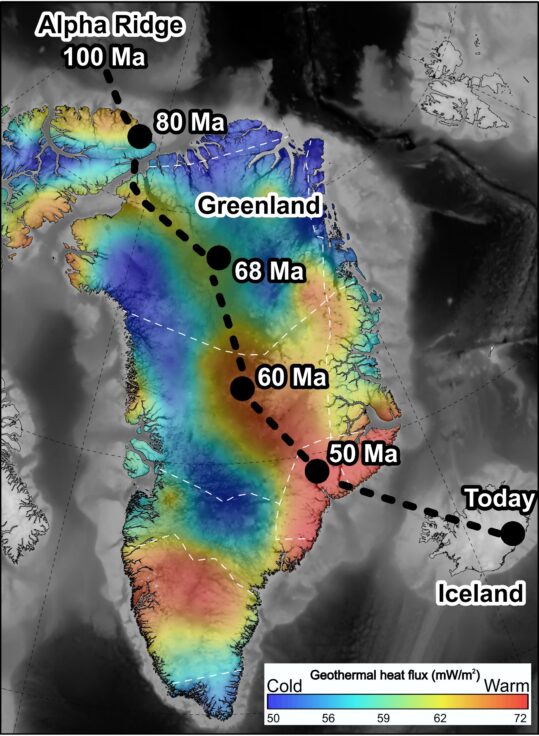“Thermal scar” from dinosaur era still warming base of Greenland Ice Sheet, new findings show
A new ‘heat map’ shows, in unprecedented detail, how geothermal heat is escaping through the Earth’s surface beneath the Greenland Ice Sheet.
This is critical information for enabling scientists to model how the massive ice sheet will respond to changes in the Earth’s climate, particularly in terms of future global sea level rise.
Published today (August 1) in Geophysical Research Letters, the new map reveals a thermal scar left on Greenland 80 million years ago as it moved over a so-called “hot spot”, or mantle plume, which today sits beneath Iceland causing its numerous volcanoes.

Researchers from NASA, British Antarctic Survey (BAS), the Royal Observatory of the Spanish Navy, Stanford University and the University of Bristol analysed data collected by aircraft flown over Greenland in past decades, which show anomalies in the Earth’s magnetic field caused by minerals in the Earth’s crust.
In some areas, deep underground temperatures of more than 530° C destroy the magnetic properties of these minerals. By identifying places without deep rock magnetic signals, the team was able to map out areas of hotter crust – i.e. where 530° C is closer to the surface.
They found a band of hotter crust, suggesting the Greenland tectonic plate had at some point passed over a mantle plume, which heated and melted the base of the plate. Magnetic properties of the minerals would have been restored when they cooled below 530°C, meaning the heat from the thermal scar is still present now – millions of years later.
This finding was backed up by gravity signals from satellites over Greenland, which are consistent with a thick layer of dense magma solidifying the base of the crust – something you would expect if Greenland had passed over a plume.
Co-author and BAS geologist Dr Tom Jordan said: “The pattern we see in Greenland is like passing a sheet of paper over a candle flame – even once you are beyond the candle you still see the mark. It’s amazing to think that the same hot spot that left an enduring mark on Greenland 80 million years ago is still active beneath Iceland causing the extensive volcanic activity that is going on today.”
Lead author Yasmina M. Martos, who began the research as a Marie Curie fellow working at BAS, now at NASA, noted: “We expected that Greenland would have a relatively uniform and low geothermal heat flow in its interior, but that turned out not to be the case. The band of high heat flux provides evidence that Greenland was moving northward over the Iceland Plume at around 80 million years ago, while dinosaurs still roamed the Earth.”
Director of Science at BAS, Professor David Vaughan, said: “The flux of heat from the crust into the bottom of Greenland Ice Sheet is unlikely to have changed significantly since the ice sheet formed three million years ago, so this is definitely not the cause of recent ice sheet changes, which are caused by atmospheric and ocean change.
“But the heat flux does contribute to shaping the ice sheet, and so this could help us understand the ice sheet’s vulnerability to future atmospheric and ocean warming.
“And along the way, we’ve discovered just one more extraordinary thing about the history of our planet.”
- The research was funded in part by the Marie Sklodowska-Curie Program of the European Commission through a fellowship held by the lead author